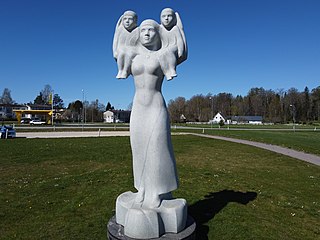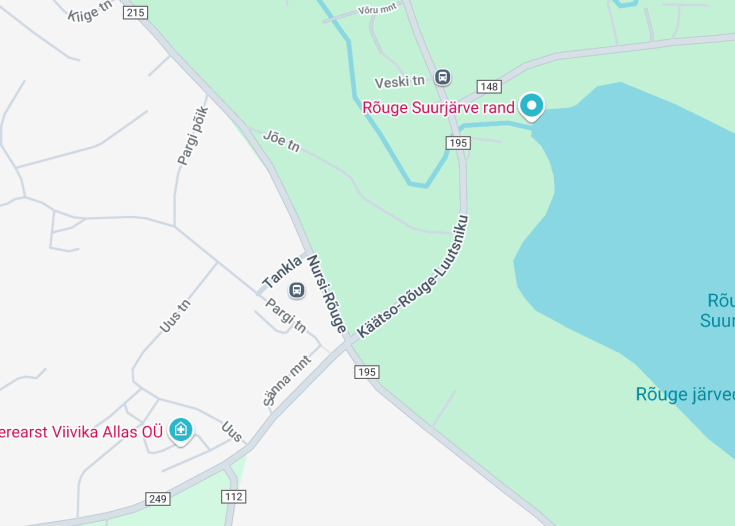The Eesti Ema monument, or “Mother Estonia,” stands as a poignant symbol of national pride in Rõuge, Estonia. This striking monument pays homage to the nurturing spirit of Estonian mothers and celebrates the essence of motherhood in the cultural heritage of the nation. It is a revered site that attracts visitors eager to connect with Estonia’s historical narratives and collective identity.
For those interested in visiting the Eesti Ema monument, consider attending during the early morning or late afternoon. This timing not only allows for a quieter experience but also provides stunning natural lighting ideal for photography.
Planning to visit Rõuge? Ensure you allocate time to explore the surrounding areas, including the picturesque lakes and hiking trails. Engaging with the local community through guided tours can enrich your understanding of the monument’s significance and the region’s history.
Eesti Ema monument: A Symbol of Estonian Heritage
The Eesti Ema monument, located in the serene town of Rõuge, Estonia, stands as a significant emblem of the nation’s history and cultural identity. This striking statue, dedicated to the mothers of Estonia, represents the strength, resilience, and nurturing spirit of Estonian women throughout the ages. Towering over the picturesque landscape, the monument is not only a tribute to motherhood but also a reminder of the sacrifices made during turbulent times.
Visiting the Eesti Ema monument is a journey into the heart of Estonian emotions, where locals and tourists alike come to pay their respects. As you approach, the lush surroundings enhance the monument’s beauty, creating a tranquil atmosphere perfect for reflection. The panoramic views from this elevated site further amplify its allure, making it a must-see for anyone exploring the unique regions of Estonia.
Activities and Attractions Near the Eesti Ema Monument
When visiting the Eesti Ema monument in Rõuge, there are several engaging activities and attractions to explore. The natural beauty of the surrounding countryside offers numerous hiking and biking trails, ideal for outdoor enthusiasts. Nearby, the enchanting Rõuge Nature Reserve features stunning landscapes, diverse flora, and fauna, presenting opportunities for birdwatching and photography.
Engage with Local History
Additionally, the local area is rich in history. Nearby, you can find the ancient Rõuge Church, which tells the story of Estonia’s past through its architecture and historic significance. Guided tours may provide deeper insights into the region’s culture and heritage, making for a fulfilling visit.
A Remarkable Feature of the Eesti Ema Monument
A fascinating aspect of the Eesti Ema monument is its artistic design, which symbolizes motherhood’s nurturing qualities. The statue portrays a mother holding her child, a representation of love and protection. This element resonates deeply within Estonian cultural narratives and serves as a poignant reminder of family values. The site also hosts annual events and gatherings, further solidifying its role as a focal point for community unity and celebration.
Discover the Majestic Eesti Ema Monument in Rõuge, Estonia
The Eesti Ema monument, known as the “Mother of Estonia,” stands as a powerful symbol of national identity and pride. This beautiful statue captures the essence of Estonian motherhood and femininity, representing the strength and resilience of the nation. Set amidst a tranquil park, it offers visitors a peaceful atmosphere to reflect on the country’s rich history and culture.
This monument is particularly inviting for families, history enthusiasts, and anyone interested in gaining insight into Estonian heritage. As you approach, you’ll be greeted with exquisite landscapes adorned with lush greenery, making it a perfect spot for a leisurely stroll or a picnic. The surrounding area often features local artisans selling crafts, allowing visitors to take home a piece of Eesti culture.
For those exploring a broader tourist route in Estonia, the Eesti Ema monument seamlessly fits into itineraries that include visits to local historical sites and natural attractions. Nearby hiking trails provide opportunities to immerse yourself in Estonia’s stunning nature, offering a satisfying blend of cultural and outdoor experiences.
Notable tips for visitors include experiencing the monument at various times of the day; sunrise and sunset provide particularly magical lighting, accentuating the beauty of this notable sculpture. Additionally, local guides recommend taking a moment to appreciate the meticulous details crafted into the monument itself, as it embodies significant elements of Estonian folklore and tradition.
When is the Best Time to Visit the Eesti Ema Monument?
The ideal time to visit the Eesti Ema monument is during the late spring and summer months, from May to August. This period offers warmer weather, allowing visitors to enjoy the outdoors comfortably. It’s also the time when the park surrounding the monument is in full bloom, enhancing the overall experience.
Annual Events Worth Attending
Each year, the Estonian Independence Day celebrations occur in February, drawing many locals and tourists to the monument. This event showcases patriotic displays, music, and communal gatherings, making it an excellent opportunity for visitors to experience the heartfelt pride of the Estonian people.
Accessibility and Limitations
While the Eesti Ema monument is accessible to the public, visitors should be aware of certain limitations.
Accessibility
Limitations
- No designated parking for large vehicles.
- Some paths may be narrow due to landscaping.
- Limited seating available in the surrounding area.
Notes to visitors
- Visitor services such as restrooms are not available on-site.
- Pets are allowed but should be kept on a leash.
- Early morning visits provide a quieter atmosphere.
General Information
Details for your visit to the Eesti Ema monument
Location
Located within a serene park setting, the Eesti Ema monument is easily accessible from various landmarks in Rõuge. Visitors can walk or use local transportation options to reach this enchanting site.
Address:
Jõe 4, Rõuge, 66201 Võru maakond
Visiting Information
The Eesti Ema monument can be visited freely, as it is located in a public park. Visitors are recommended to arrive either early in the morning or during the late afternoon for the best experience, particularly to enjoy the tranquil environment and avoid crowds.
How to Reach the Destination
Reaching the Eesti Ema monument is straightforward. Here are the main transportation options:
Car
Traveling by car is a convenient option, and there are several nearby parking areas available for visitors.
| Route | Distance | Travel time |
|---|---|---|
| From Tartu | 80 miles (128 km) | 1 hour 30 minutes |
| From Tallinn | 160 miles (257 km) | 2 hours 30 minutes |
| From Võru | 15 miles (24 km) | 20 minutes |
Public Transport
If you prefer public transportation, local buses run frequently from nearby towns, making travel to the site easy and efficient.
| Route | Distance | Travel time |
|---|---|---|
| From Võru by Bus | 15 miles (24 km) | 30 minutes |
| From Tartu by Bus | 80 miles (128 km) | 2 hours |
Nearby Attractions
- Rõuge Nature Reserve – 5 miles (8 km)
- Rõuge Suurjärv Lake – 1 mile (2 km)
- Võru County Museum – 12 miles (19 km)
- Haanja Nature Park – 9 miles (14.5 km)
- Lake Õrsjõgi – 7 miles (11 km)
- Haanja Tower – 10 miles (16 km)
- Võru Town Hall – 12 miles (19 km)
- Estonian Museum of Applied Art and Design – 12 miles (19 km)
- Võru Shopping Centre – 12 miles (19 km)
- Võru Sport Centre – 12 miles (19 km)
- St. Catherine’s Church in Võru – 12 miles (19 km)
- Võrtsjärv Lake – 30 miles (48 km)
Common Questions
What is the history behind the Eesti Ema monument in Rõuge?
What does the Eesti Ema monument symbolize?
Who designed the Eesti Ema monument?
What is the location of the Eesti Ema monument in Rõuge?
Are there any myths or legends associated with the Eesti Ema monument?
What materials were used to build the Eesti Ema monument?
What are the nearby attractions to the Eesti Ema monument?
- Rõuge Hiking Trails: A range of scenic trails that allow visitors to explore the beautiful landscapes surrounding the monument.
- Rõuge Suurjärv: The largest lake in the area, offering opportunities for swimming, boating, and picnicking.
- Rõuge Church: A charming wooden church that adds to the historical ambiance of the region, showcasing local architecture.
- Lake Uljaste: Known for its clear waters and relaxing environment, it’s a perfect spot for visitors seeking tranquility.
- Observation tower: Near Rõuge, this tower gives breathtaking views over the local countryside and lakes, ideal for photography enthusiasts.
These attractions make the area around the Eesti Ema monument a wonderful destination for nature lovers, history buffs, and families looking to explore the unique cultural tapestry of Estonia. Visitors can easily spend a day delving into both the natural and cultural riches available in Rõuge.
What is the artistic style of the Eesti Ema monument?
Is there any significance of the surrounding landscape of the Eesti Ema monument?

Is the Eesti Ema monument in Rõuge, Estonia worth visiting?
The Eesti Ema monument in Rõuge, Estonia, is a significant cultural landmark that pays homage to the mother figure in Estonian society. Its striking design and location amidst picturesque landscapes make it a lovely spot for photography enthusiasts and those interested in Estonian heritage. However, the monument is somewhat isolated, which might pose challenges for tourists without access to transportation. While it may not be a must-see destination for everyone, if you’re in the area or have a particular interest in Estonian culture, the monument certainly warrants a visit. Its peaceful surroundings and the story behind it can offer a unique experience for those who appreciate historical and cultural sites.









